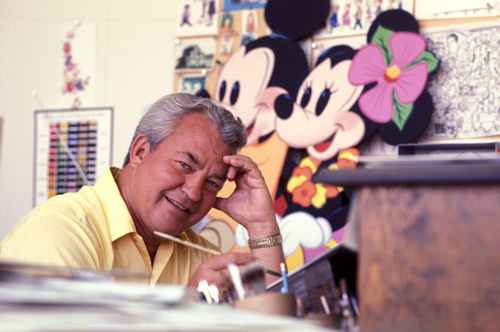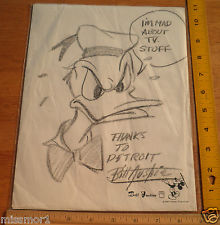
Bill Justice. (Photo via The Walt Disney Family Museum)
Bill Justice joined The Walt Disney Studios in 1937 where he quickly rose from in-betweening to full animation. Perhaps the characters he is most closely associated with are the mischievous Chip’n Dale as he animated almost all of their appearances in theatrical shorts.
 Walt Disney moved Bill to Walt Disney Imagineering (then known as WED) in 1965, where he programmed Audio-Animatronics figures. After 42 years with the company, Bill retired in February 1979. He wrote a book about his career at Disney called Justice for Disney, which was published by Tomart Publications in 1992 and is long overdue for an updated, revised edition to be issued. Bill was inducted as a Disney Legend in 1996.
Walt Disney moved Bill to Walt Disney Imagineering (then known as WED) in 1965, where he programmed Audio-Animatronics figures. After 42 years with the company, Bill retired in February 1979. He wrote a book about his career at Disney called Justice for Disney, which was published by Tomart Publications in 1992 and is long overdue for an updated, revised edition to be issued. Bill was inducted as a Disney Legend in 1996.
I had the opportunity to meet and talk with Bill Justice at the various Mouse Club and NFFC events in the Anaheim area in Southern California but I never made time to sit down and formally interview him until he visited Walt Disney World in Florida when I was working as an animation instructor at the Disney Institute.
One night in March 1997 when I was performing comedy magic and making balloons animals at Give Kids the World, a location devoted to terminally ill children and their families, I was pleasantly surprised to see Bill Justice and his wife Kim show up. They were there so Bill could do some sketching of Disney characters for the kids.
So the next day over an extended lunch at the Disney Institute, Bill graciously answered some questions before his presentation that evening for guests and staff at the Disney Institute. Here are some excerpts.
Jim Korkis: How did you end up working at Disney?
Bill Justice: I answered that ad they ran in magazines and they asked me to come to a tryout class at Disney. Thirty days and there were thirty of us from all over the country. I was making $65.00 a week working two jobs and doing some freelance art and Disney offered me $12.00 a week and no guarantee of a job but I was excited about working at Disney.
July 17, 1937 was my first day at Disney. I showed up wearing my best suit and that was a mistake. I wanted to make a good impression. Los Angeles was very, very hot and there was no air conditioning at the Hyperion Studio so the other guys looked at me like I was a hick. The next day I dressed more comfortably.
 JK: What was the training like?
JK: What was the training like?
BJ: While we were going to this training class, we were primarily being taught in-betweening. You also had a lot of life drawing. The problem I had with the life drawing class was I had made a habit of making things look like what I saw. Don Graham, who was the instructor, was trying to teach us how to be a cartoonist. I didn’t realize we were supposed to be caricaturing what we saw instead of making it look realistic so it was difficult for me to make it look more like a cartoon.
Graham’s class was at 8:00 am in the morning and then at noon John Dunn taught in-betweening. He was inspirational but very critical. It was a tough job to teach us and evaluate us in thirty days.
At the end of thirty days, there were twelve of us who were hired. Two years later, I was the only one left from that group still working at the Studio. As an in-betweener my pay went up to $25 a week.
As an in-betweener, we worked in the annex across from the main building at Hyperion. They would bring scenes over and we would just in-between and they would take them back. They were rushing to finish up “Snow White”. Nobody explained the story to us. The first thing I had to in-between was the queen in “Snow White” who was talking to the mirror and her lips just moved very slightly. I had to use a very, very sharp point on a hard pencil. After that, I got to in-between the dwarfs and I just loved that. I think the Seven Dwarfs and the Three Little Pigs were the best characters ever designed.
I got to go to the premiere at the Carthay Circle Theater and one of the things that stuck in my mind were those hideous dwarf costumes they had there. It was a wonder that it didn’t scare people away from the theater.
JK: Tell me a little about the “Snow White Orgy” at the Narconian.
BJ: In 1938, “Snow White” was a huge hit. You can’t believe how bit it was. Walt and Roy announced that they were going to throw this huge, incredible “thank-you” party for everyone who worked for them. Wives, husbands, children, friends…all of them were invited to a weekend at the Narconian Hotel on Lake Narco (a desert resort near Palm Springs where Walt would later have his Smoke Tree Ranch hideaway).
All costs from the rooms to food and drink and in fact whatever we wanted to order would be taken care of by Walt. You know at the Studio, there was a strict dress code in those days for employees. Men came to work in jackets and ties although they were allowed to take them off when they sat down at their drawing boards. Women were not allowed to wear pants, and sober-colored skirts and blouses weren’t very appealling. The ink and paint girls were separated from the animators.
 The Disney Brothers had sent out a memo that if you were in animation you weren’t supposed “to dip your pen in the company’s ink and paint “which was their way of saying, “behave yourself with the ink and paint girls”. If you told a dirty joke within earshot of Walt, you might get fired. He didn’t put up with any of that stuff.
The Disney Brothers had sent out a memo that if you were in animation you weren’t supposed “to dip your pen in the company’s ink and paint “which was their way of saying, “behave yourself with the ink and paint girls”. If you told a dirty joke within earshot of Walt, you might get fired. He didn’t put up with any of that stuff.
So, anyway for two years, all of us had been under terrible pressure, working long hours day and night to finish “Snow White”. When I came on at the end of production, I still felt that stress. When we arrived at the Narconian Hotel there were pools to swim in, tennis courts, a golf course, music, and plenty of food and alcohol and something just snapped.
An animator picked up an ink and paint girl and dumped her into the pool fully clothed. Followed by others jumping in and all hell broke loose pretty quickly. Swimsuits flew out the windows. There were naked swim parties, people got drunk and were often surprised what room they were in and who they were sleeping next to when they awoke the next morning.
Freddie Moore walked off one of the upper floor balconies thinking he was on the ground floor and ended up in a tree fortunately. You know, he was one of my idols. I never saw Freddie Moore do a bad drawing. As my wedding gift from my wife, Kim, I got a sketch of a woman’s head wearing a hat done by Freddie.
Walt was horrified at the shenanigans. He and his wife drove home that next morning. He never referred to that party again and in fact if you wanted to keep your job, you didn’t mention it either when you were working at the studio. We never had a party like that again.


 Jim Korkis is an internationally respected animation historian who in recent years has devoted his attention to the many worlds of Disney. He was a columnist for a variety of animation magazines. With his former writing partner, John Cawley, he authored several animation related books including The Encyclopedia of Cartoon Superstars, How to Create Animation, Cartoon Confidential and Get Animated’s Animation Art Buyer’s Guide. He taught animation classes at the Disney Institute in Florida as well as instructing classes on acting and animation history for Disney Feature Animation: Florida.
Jim Korkis is an internationally respected animation historian who in recent years has devoted his attention to the many worlds of Disney. He was a columnist for a variety of animation magazines. With his former writing partner, John Cawley, he authored several animation related books including The Encyclopedia of Cartoon Superstars, How to Create Animation, Cartoon Confidential and Get Animated’s Animation Art Buyer’s Guide. He taught animation classes at the Disney Institute in Florida as well as instructing classes on acting and animation history for Disney Feature Animation: Florida.




















































“He wrote a book about his career at Disney called Justice for Disney, which was published by Tomart Publications in 1992 and is long overdue for an updated, revised edition to be issued”
But considering that Bill Justice died in 2011, how would a revised edition ever happen?
A ghostwriter?
I was unclear. When I suggested a REVISED edition, I was alluding to supplemental material like a list of corrections (like Disney Archivist Dave Smith did for the Pete Martin/Diane Disney Miller 2005 reprint of the Walt biography THE STORY OF WALT DISNEY for a special limited hardcover edition ), some additions like an annotated filmography, or even some additional material from other interviews Bill did over the years. I was asked by his wife if I was interested in ghostwriting an update for no pay to submit to Hyperion Press but I turned down the offer because I was too busy at the Disney Institute and taking care of my folks. Tom Tumbusch still has the original unedited interviews with Bill including material that did not make it into the final book, primarily stuff about the many cruises he went on and entertained guests.
Among other things, I think Justice did character costume designs for the “Disney on Parade” show.
http://postimg.org/image/xe9bn5pul/